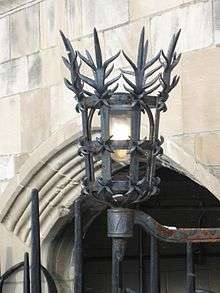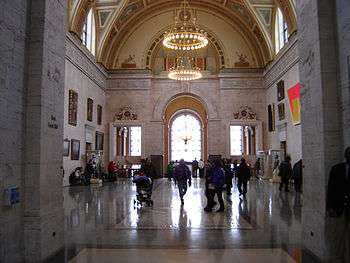Samuel Yellin

Samuel Yellin (1885–1940), was an American master blacksmith, and metal designer.
Career
Born in Galicia, Poland where at the age of eleven he was apprenticed to an iron master. By the age of sixteen he had completed his apprenticeship. During that period he gained the nickname of "Devil," both for his work habits and his sense of humor. Shortly after this he left Poland, traveling through Europe to England, and from there, in 1906, he departed for America. By 1907 he was taking classes at the Philadelphia Museum School of Industrial Art and within a year was teaching classes there, a position that he maintained until 1919.

In 1909, he opened his own shop and in 1915 the firm of Mellor, Meigs & Howe, for whom he designed and created many commissions, designed Yellin a new studio at 5520 Arch Street in Philadelphia where he was to remain until his death in 1940. The building continued to act as a functioning business under Yellin’s son, Harvey’s direction. After his demise it served as the Samuel Yellin Museum.
During the building boom of the 1920s, Yellin’s studio employed as many as 250 workers, many of them European artisans. Although Yellin appreciated traditional craftsmanship and design, he always championed creativity and the development of new designs. Samuel Yellin’s handiwork can be found on some of the finest buildings in America.
Honors
Yellin received awards from the Art Institute of Chicago (1919), the American Institute of Architects (1920), the Architectural League of New York (1922), and the Bok Civic Award from the City of Philadelphia (1925).[1] He was a member of the Philadelphia Chapter of the American Institute of Architects and the T Square Club, the Philadelphia Sketch Club, and the Architectural League of New York.
Legacy
- Samuel S. Yellin Elementary School in Camden, New Jersey, is named for him.
Selected works
Universities, colleges and schools

- Annapolis Colored High School, Annapolis, Maryland
- Bowdoin College
- Bryn Mawr College
- California Institute of Technology, Pasadena, California
- Drexel Institute, Philadelphia, Pennsylvania
- Eastman School of Music, Rochester, New York
- Harvard University, Cambridge, Massachusetts
- Haverford College
- Jewish Theological Seminary, New York, New York
- Oberlin College, Oberlin, Ohio
- Princeton University, Princeton, New Jersey
- Swarthmore College
- University of Chicago, Chicago, Illinois
- University of Michigan, Ann Arbor, Michigan
- University of Pennsylvania, Philadelphia, Pennsylvania
- University of Pittsburgh, Pittsburgh, Pennsylvania
- University of Texas at Austin, Austin, Texas
- University of Tulsa, Tulsa, Oklahoma
- University of Virginia, Charlottesville, Virginia
- Vanderbilt University, Nashville, Tennessee
- Yale University, New Haven, Connecticut
- Harkness Tower (gates)
- Swartwout Building, Yale University Art Gallery
- Robinson Memorial Gateway, Bowdoin College.
 Entrance gates (1924), Curtis Institute of Music, Philadelphia.
Entrance gates (1924), Curtis Institute of Music, Philadelphia. Great Hall, Bryn Mawr College.
Great Hall, Bryn Mawr College. Cathedral of Learning, University of Pittsburgh.
Cathedral of Learning, University of Pittsburgh. Stephen Foster Memorial, University of Pittsburgh.
Stephen Foster Memorial, University of Pittsburgh.
Institutional and commercial
(Alphabetical by state)
- San Diego Air Station, San Diego, California
- Aetna Life Insurance Co, Hartford, Connecticut
- Peabody Museum, New Haven, Connecticut
- Bok Singing Tower, Lake Wales, Florida
- Sarasota Court House, Sarasota, Florida
- Union Pacific RR Station, Boise, Idaho
- Art Institute of Chicago, Chicago, Illinois
- Union Station, Indianapolis, Indiana
- Baltimore Trust Company, Baltimore, Maryland
- Detroit Institute of Art, Detroit, Michigan
- Detroit Public Library, Detroit, Michigan
- Detroit Society of Arts and Crafts, Detroit, Michigan
- Grand Rapids Art Gallery, Grand Rapids, Michigan
- University of Michigan Law Library, Ann Arbor, Michigan
- Morristown Memorial, Morristown, New Jersey
- Ritz-Carlton Hotel, Atlantic City, New Jersey
- Victor Talking Machine Co, Camden, New Jersey
- American Radiator Building, New York
- Barclay-Vesey Building, New York
- Central Savings Bank, New York
- The Cloisters (Metropolitan Museum of New York), New York, New York
- Dime Savings Bank, New York
- Federal Reserve Bank of New York, New York
- Ford Motor Company, New York
- General Motors Co., New York
- International Business Machine (IBM) New York
- Salvation Arm Headquarters, New York, New York
- Allegheny County Courthouse, Pittsburgh, Pennsylvania
- Fidelity Mutual Life Insurance Company Building, Philadelphia, Pennsylvania
- Candoro Marble Works (showroom door), Knoxville, Tennessee
- Fidelity Bankers Trust, Knoxville, Tennessee
- Seattle Art Museum, Seattle, Washington
- Citizens Bank, Weston, West Virginia
- Great Brass Door, Bok Singing Tower, Lake Wales, Florida
 Art Institute of Chicago, Chicago, Illinois
Art Institute of Chicago, Chicago, Illinois Detroit Institute of Art, Detroit, Michigan
Detroit Institute of Art, Detroit, Michigan
Ecclesiastical
- Baltimore Pro-Cathedral, Baltimore, Maryland
- Blessed Sacrament Cathedral, Detroit, Michigan
- Congregation Emanu-El of the City of New York, NY
- Grace Cathedral, San Francisco, California
- Holy Trinity Lutheran Church, Akron, Ohio
- Park Avenue Christian Church, New York
- Salt Lake City Cathedral, Salt Lake City, Utah
- St. Bartholomew’s Church, New York
- St John’s Cathedral, Denver, Colorado
- Cathedral of St. John the Divine, New York
- St. Joseph's Roman Catholic Church, Canaan, Connecticut
- Episcopal Church of the Evangelist, Philadelphia, Pennsylvania. Now Fleisher Art Memorial.
- St. Mark's Episcopal Church (Philadelphia, Pennsylvania), Pennsylvania
- St. Patrick’s Cathedral, New York
- St. Patrick’s Church, Philadelphia, Pennsylvania
- St. Thomas Church, New York
- St. Vincent Ferrer, New York
- Washington National Cathedral, Washington D.C.
- Washington Memorial Chapel, Valley Forge Pennsylvania
 Harrison Memorial Gates (1918), Washington Memorial Chapel, Valley Forge.
Harrison Memorial Gates (1918), Washington Memorial Chapel, Valley Forge.- Fiske Portal (1922-23), St. Mark's Episcopal Church, Philadelphia.
- Cross & candlesticks (1925), Resurrection Chapel, Washington National Cathedral.
- Entrance grille (1934), Fleisher Art Memorial, Philadelphia.
Residential
(Alphabetical by state)
- Winterthur, Henry DuPont residence, Wilmington, Delaware
- Dumbarton Oaks, Robert Woods Bliss residence, Washington, D.C.
- Havemeyer Residence, Chicago, Illinois
- Cyrus McCormick residence, Chicago, Illinois
- Cranbrook, George Gough Booth residence, Bloomfield Hills, Michigan
- Fred Fisher residence, Detroit, Michigan
- William E. Scripps Estate, Lake Orion, Michigan[2]
- George H. Christian Mansion, Minneapolis, Minnesota (current home of Hennepin History Museum)
- Frick Residence, New York
- Isaac Guggenheim residence, Port Washington, New York
- Gates for estate of J.P. Morgan, Long Island, New York
- Elie Nadelman residence, New York
- Mrs. P.A. Rockefeller residence, Fayetteville, New York
- Walter Rosen, Caramoor, Katonah, New York
- Reynolda House, Winston-Salem, North Carolina
- Stan Hywet Hall, Frank A. Seiberling residence, Akron, Ohio
- E.W. Marland Estate, Ponca City, Oklahoma
- Edward Bok residence, Philadelphia, Pennsylvania
- Henry F. Miller residence, Philadelphia, Pennsylvania, G. Edwin Brumbaugh, architect[3]
- High Hollow, George Howe residence, Philadelphia, Pennsylvania
- Andrew W. Mellon residence, Pittsburgh, Pennsylvania
- Cornelius Vanderbilt Whitney residence, Deer Run, Pennsylvania
Architects whose names appear in Yellin’s job book
- Ralph Adams Cram
- Cram & Ferguson Offices, NY NY
- Paul Cret
- Charles Day
- Cass Gilbert
- Bertram Goodhue
- George Howe
- Benno Janssen
- Charles Klauder
- Walter Mellor
- Arthur Ingersoll Meigs
- Horace Trumbauer
- Walker and Gillette, NY
- Alfred Zantzinger, Haverford PA
References

- ↑ Samuel Yellin – Biography, from Philadelphia Architects and Buildings.
- ↑ http://www.friendsofscrippsestate.org/architecture.html
- ↑ Winterthur Museum, Collection of G. Edwin Brumbaugh.
- ↑ Wenzel, Paul and Maurice Krakow, A Monograph of the Works of Mellor Meigs & Howe, The Architectural Book Publishing Co., New York, 1923, reprinted Graybooks, Boulder, CO, 1991 p. 104
Sources
- Andrews, Jack, Samuel Yellin – Metalsmith, Skipjack Press, Ocean Pines Maryland, 2000
- Andrews, Jack, Samuel Yellin, Metalworker, Anvil’s Ring, Summer, 1982
- Architecture magazine, April 1929
- Bach, Penny Balkin, Public Art in Philadelphia, Temple University Press, Philadelphia, Pennsylvania, 1992
- Bedford, Steven McLeod, John Russell Pope – Architect of Empire, Rizzoli International Publications, NY, NY 1998
- Bok, Edward W., America’s Taj Mahal – The Singing Tower of Florida, The Georgia Marble Company, Tate, Georgia c. 1929
- Davis, Myra T., Sketches in Iron, no publishing information
- Detroit Institute of Arts – The Architecture, The Detroit Institute of Arts 1928
- Fariello, Anna, "Samuel Yellin: Sketching in Iron," Metalsmith Magazine Fall 2003 http://www.ganoksin.com/borisat/nenam/samuel-yellin.htm
- Federman, Peter, The Detroit Public Library, Classical America IV, Classical America 1977
- Gallery, John A., Editor, Philadelphia Architecture – A Guide to the City, MIT Press, Cambridge, Massachusetts 1984
- Harrington, Ty, "The Wizardry of Samuel Yellin, Artist in Metals," Smithsonian Magazine, vol 12, no. 12 (March 1982), pp. 65-75
- Heilbrun, Margaret, The Architecture of Cass Gilbert, Inventing the Skyline, Columbia University Press, New York, NY 2000
- Kvaran, Einar Einarsson, Architectural Sculpture of America, unpublished manuscript
- Teitelman, Edward & Richard W. Longstreth, Architecture in Philadelphia – A Guide, MIT Press, Cambridge, Massachusetts 1981
- Wattenmaker, Richard J., Samuel Yellin In Context, Flint Museum of Arts, Flint, Michigan 1985
- Wister, Cret, Gilchrist et al., Melor Meigs & Howe, Graybooks, Boulder Colorado 1991 (reprint of 1923 work)
External links
- Samuel Yellin, Iron Worker, at Philadelphia Architects and Buildings
| Wikimedia Commons has media related to Samuel Yellin. |